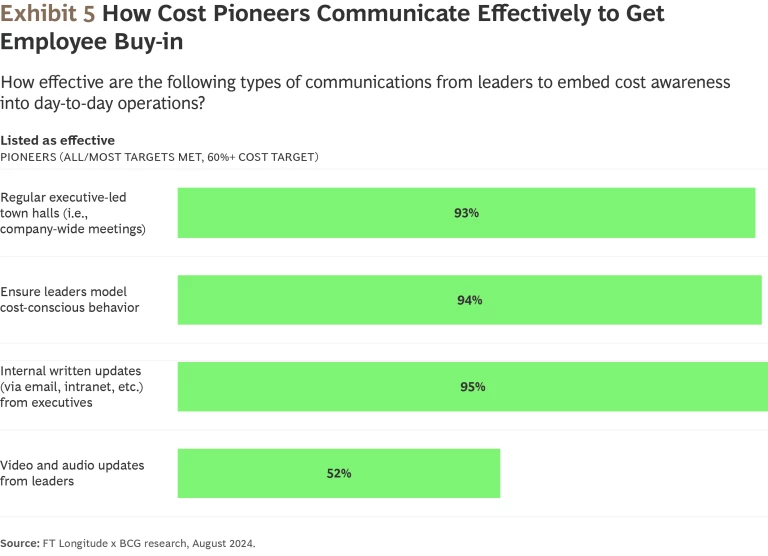As cost pressures intensify globally, many companies scramble for short-term fixes. But what if you could achieve cost excellence, not just for today, but for the future?
Some organizations take a forward-looking approach. Rather than focusing on temporary gains, they take a broad, in-depth look at all costs and make thoughtful changes across the business to ensure long-term efficiency.
What sets these companies apart from the rest?
To find out, we surveyed 770 CEOs, CFOs, and COOs across 21 countries. As our new report,
Leading Edge: How Pioneering Companies Achieve Cost Excellence
, shows, the results are striking. Top performers make continuous, organization-wide
cost management
a top priority. They’re driving cost awareness in their teams and embedding it within the company culture. And they’re deploying advanced technology like
generative AI
to stay competitive. These companies, which range from $100 million to more than $100 billion in revenue and represent a diverse set of industries, highlight the broad applicability of these strategies.
Five Key Takeaways on Cost Excellence
Cost management is better when it’s always on. Too often, cost management programs fail to show the desired results. This may be because:
- Expectations are too high.
- Timeframes are unrealistic.
- The approach is not rigorous or broad enough—perhaps it only looks at specific parts of the organization or certain types of costs.
Our research shows that the most successful cost optimization is an ongoing process, always being refined and reviewed. In other words, it’s always on . Companies that do this outperform those that rely on one-off or short-term approaches. (See Exhibit 1.)
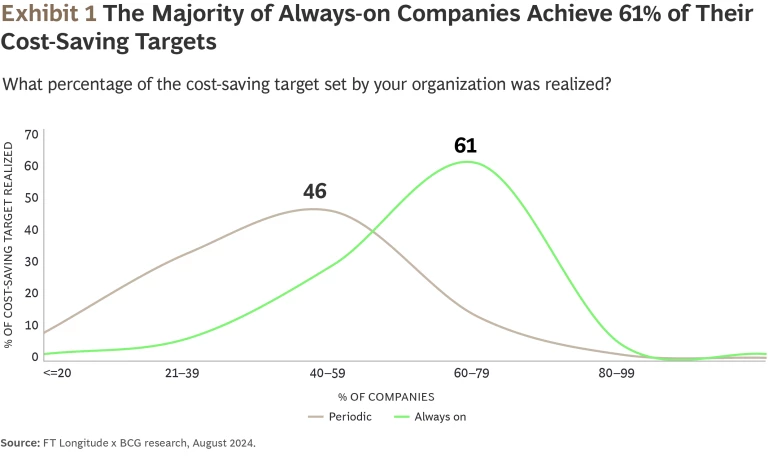
There’s more than just cost competitiveness to gain. To excel in cost management, organizations must embed cost consciousness deep into company culture, driving continuous improvements in cost structures through new technologies and smarter ways of working.
The always-on approach delivers benefits beyond cost. The ability to demonstrate continuous cost improvements and make credible arguments for reinvestments in growth areas will increase investor value. In our research, the organizations that focus on continuous cost improvements also outperform the rest across five other benchmarks, including financial risk exposure and competitive position. (See Exhibit 2.)
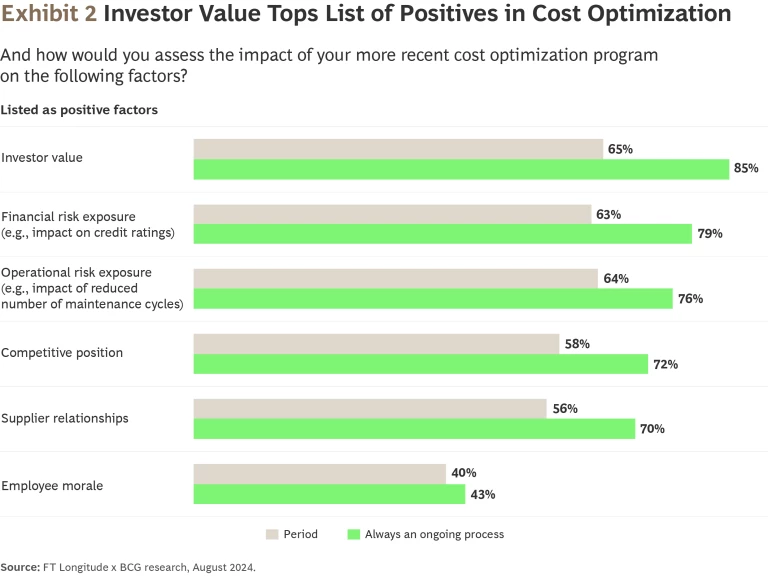
Move from quick wins to long-term efficiency with AI . The use of AI to improve costs is already close to universal: 93% of companies in our research either use it now or plan to within the next 18 months.
Unlocking AI’s full value and translating it into real P&L savings requires the reimagination of end-to-end processes. Companies also need to be being vigilant about rising tech expenses and hidden costs as AI scales.
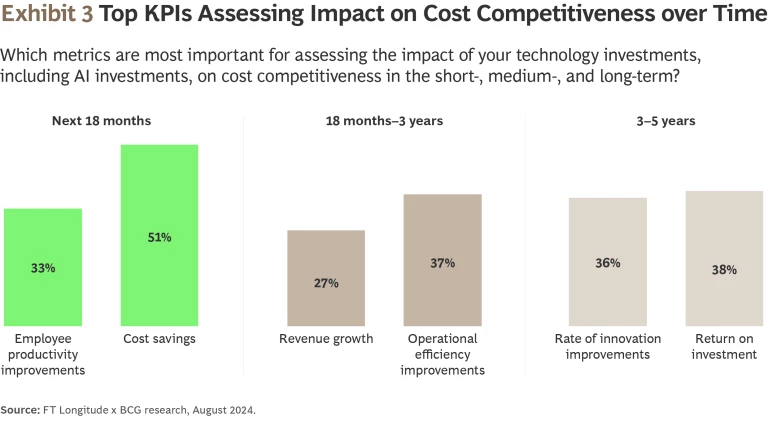
But business leaders have a clear view of AI’s strategic potential. (See Exhibit 3.) As new and more advanced AI tools evolve, they are expected to become pivotal in driving sustained cost competitiveness and improvement:
- Within the next three years, success metrics will shift toward deeper operational efficiency improvements. By then, business leaders also expect that the technology will contribute to revenue growth.
- In five years, AI’s impact will be measured by its contribution to cost efficiency based on return on investment and its ability to foster innovation.
AI leaders have the advantage. Cost pioneers—about 20% of businesses in our research—are outperforming their peers on operational and cost improvement goals, and a key driver of their success is heavy investment in AI. (See Exhibit 4.)
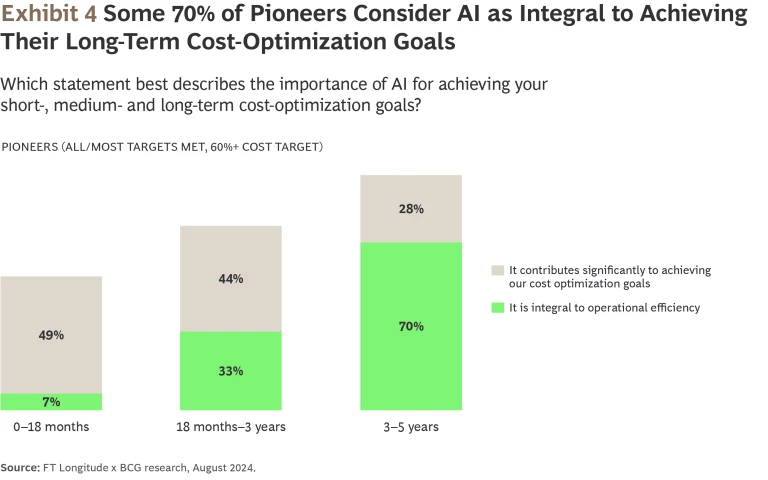
Pioneers:
- 49% say AI is already contributing significantly to better cost competitiveness.
- 70% anticipate AI will be core to achieving operational efficiency within three to five years.
Underperformers:
- Only 12% describe AI as a significant contributor to their operations .
- Only 27% expect AI to become core to achieving operational efficiency in three to five years.
Change management and company culture drive cost optimization. Cost optimization requires significant organizational change, which can be met with resistance, particularly when new technologies like AI are involved. Here, again, cost pioneers enjoy a privileged position. While the majority of companies report no change to morale or a decline in morale in response to cost programs, 62% of cost pioneers report a positive impact.
Effective change management and strong leadership can make the difference between success and failure. To accelerate the shift toward cost consciousness, business leaders should craft a compelling change narrative. This explains the plan, the thinking behind it, and any tough messages with transparency, clarity, and humanity.
The CEO is central to change management:
- 82% of cost pioneers communicate from the top of the organization to embed cost awareness into day-to-day operations. That compares to just 37% of underperforming businesses.
- For 93% of pioneers this includes executive-led town halls. (See Exhibit 5.)
- An equally large proportion makes sure that managers model cost-conscious behavior.
